Open the MultiSelection.CATPart document.
-
Click Modification
 in the Modification toolbar.
in the Modification toolbar. -
Select Subdivision Surface.1.
-
Click Multi-Selection
 .
.
You can also access this command by pressing CTRL+SPACE. -
Press Crtl key and select Subdivision Surface.3.

-
Click Multi Selection
 and
you are back to Modification
and
you are back to Modification
 command.
command.
- In case
of multiple selection of subdivision surfaces, each subdivision mesh
is displayed in a different color for easier
identification.

- To display the meshes in same default color, clear the
check box Automatic colored in Multi-Selection Mode in
Tools > Options > Shape > Imagine & Shape > Display tab.
The default color is as specified in
Tools > Options > General > Display > Visualization
tab, Color area.

- There is no set rule for the order of colors to be displayed. If you deselect or reselect a subdivision, its color may change.
- Selected elements are displayed in red color and the pre-selected elements in orange as the previous behavior and these colors are kept for the elements in all the meshes.
Modification of Multiple Surfaces
-
Select the faces on these two subdivision surfaces. You can use the Ctrl key to multi-select the faces. You can add, remove and change the selected faces.

The All Elements Selection
 will select all the faces of the two subdivision surface.
will select all the faces of the two subdivision surface. -
Click Translation
 .
. -
Move the mouse cursor to highlight the desired axis or plane.
-
Hold down the left-mouse button and drag to translate the surfaces.

-
Release the left-mouse button when you are satisfied with the new position of the surfaces.
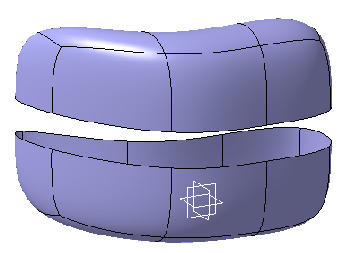
Use One Subdivision Surface to Modify Another
-
Click Compass Definition
 to define the compass' position on Subdivision Surface.3.
to define the compass' position on Subdivision Surface.3.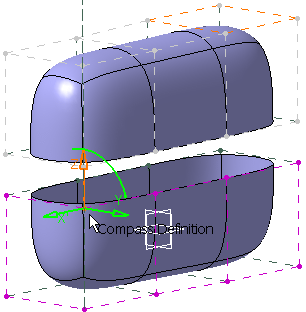
-
Click Compass Definition
 again.
again. -
Click Alignment
 .
. -
Select the multiple edges or vertices on Subdivision Surface.1 to align them on Subdivision Surface.3. You can use the Ctrl key to multi-select the vertices. You can add, remove and change the selected vertices.
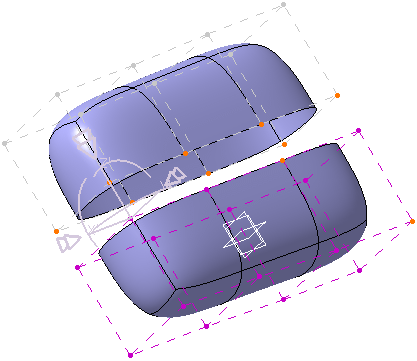
-
Click the manipulator to project the edges.
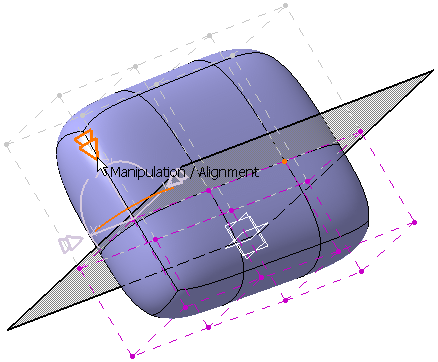
You can see that the edges are projected.
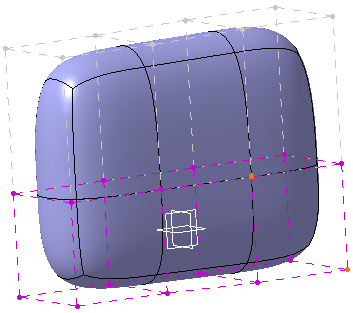
The result is: 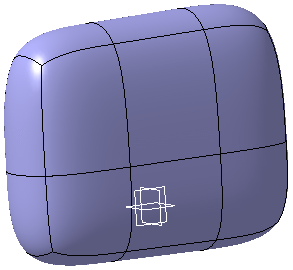
- All modification commands can be applied to multiple surfaces.
- When you work with more than a one subdivision surface, if the working zone option is activated (or deactivated); it will be activated (or deactivated) for the entire selected subdivision surfaces. For more information on working zone, refer to Defining The Working Zone.
- If you have selected the faces or edges or vertices of a subdivision, and further deselected the subdivision, then reselecting this subdivision will highlight all previously selected elements.
Smart Selection of Multiple Surfaces
Open the SmartSelection.CATPart document.
-
Select
EdgeFillet.1 and click Modification
 to modify it.
You can see that all the parent subdivision surfaces are highlighted in
the specification tree. The Tools Palette
also appears.
to modify it.
You can see that all the parent subdivision surfaces are highlighted in
the specification tree. The Tools Palette
also appears. -
Press
Ctrl
key and select the parent subdivision surfaces you want to modify.
In this case select two subdivision surfaces. -
Click
End Selection
 in the Tools Palette
to validate the selection.
You can see that the selected subdivision surfaces can now be modified.
in the Tools Palette
to validate the selection.
You can see that the selected subdivision surfaces can now be modified.

![]()